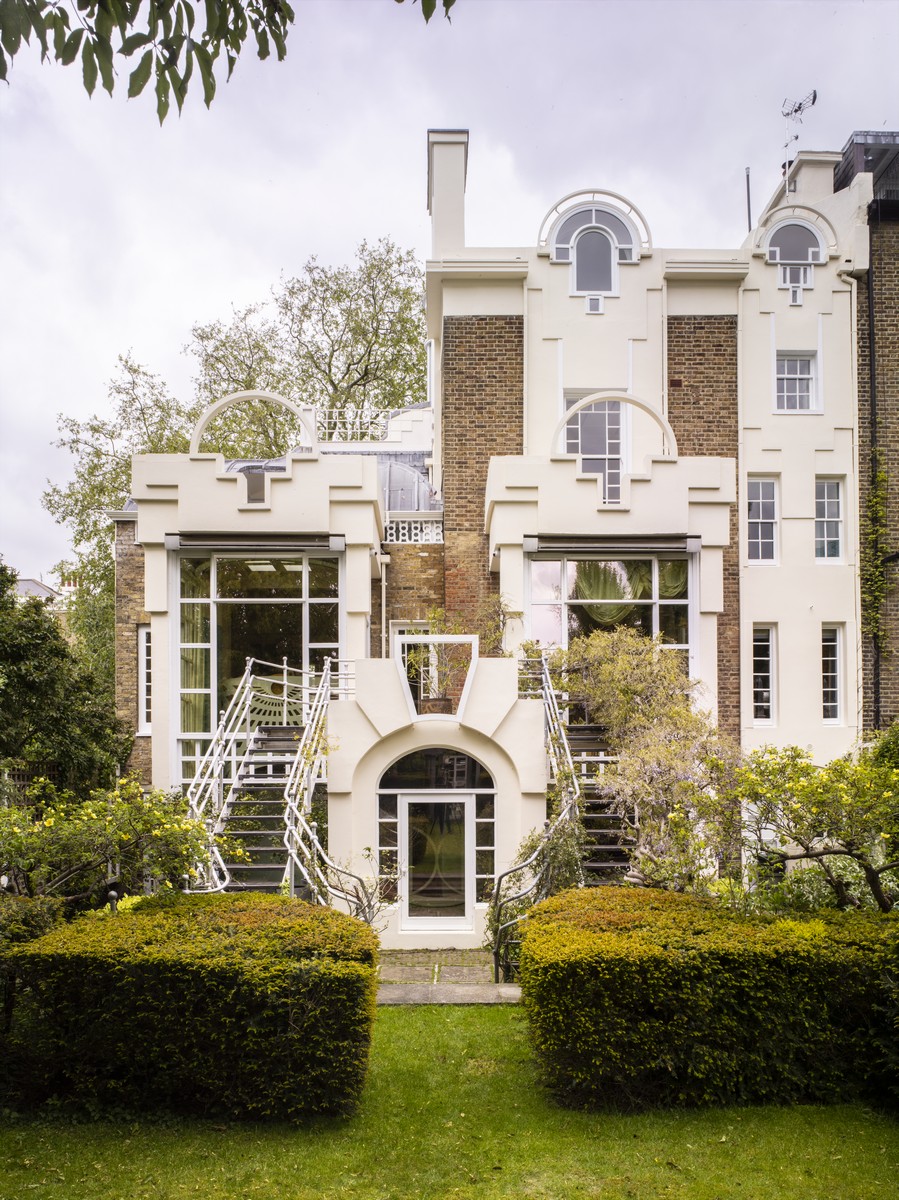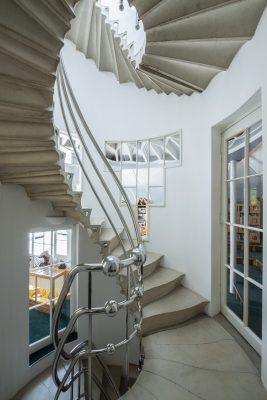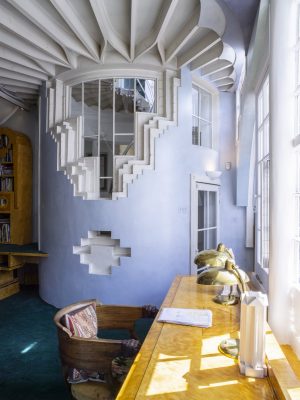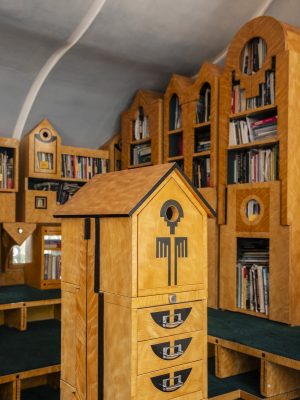The Cosmic House West London, Holland Park Home by Charles Jencks, Residential Architecture Photos
The Cosmic House in Holland Park
14 September 2022
Design: Charles Jencks Architect
Location: north west London, England, UK
The Spring Room with fireplace designed by Michael Graves, crowned with female representations of the 3 months of spring by Penelope Jencks:
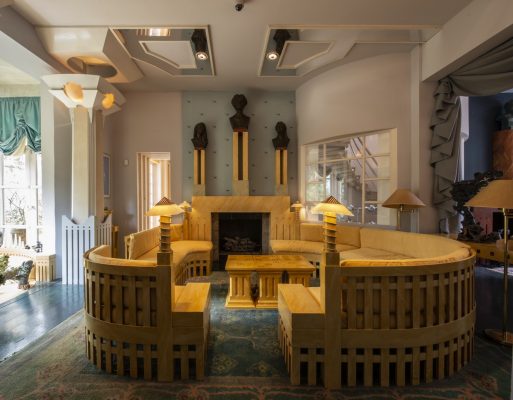
Photographs by Sue Barr
Maggie Jencks’s Voice Brought To Life At The Cosmic House In New Site-specific Installation By Artist-in-residence Marysia Lewandowska
The Spring Room in The Cosmic House
A new site-specific sound installation how to pass through a door by the Jencks Foundation’s first artist-in-residence Marysia Lewandowska, will be inaugurated at The Cosmic House on 10 October, marking the anniversary of Maggie’s birthday.
The work activates Maggie’s voice using both spoken recordings and written texts from the archive, ranging from her formal lectures to the more intimate letters and detailed notes about the construction of the house. Lewandowska constructs an alternative narrative, as if a visitor is on a guided tour by Maggie herself, opening up different viewpoints and interpretations to those of her collaborator and husband, Charles Jencks.
Lewandowska, who has explored the public functions of archives, museums and exhibitions in her work over the past 20 years, was invited by the Jencks Foundation to review the holdings of the Jencks archive. Her practice of recovering women’s cultural contributions through the use of voice, has been developed in her previous projects such as Women’s Audio Archive (2009) and It’s About Time at the 58th Venice Art Biennale (2019).
The sound installation, with the title borrowed from one of Maggie’s notebooks commenting on the design of The Cosmic House, is the culmination of the artist’s one-year-long sustained engagement with the Jencks archives in London and in Portrack, Scotland.
Maggie Keswick Jencks, photographed during her 1974 trip to East Asia, researching history and design of gardens for her book The Chinese Garden:
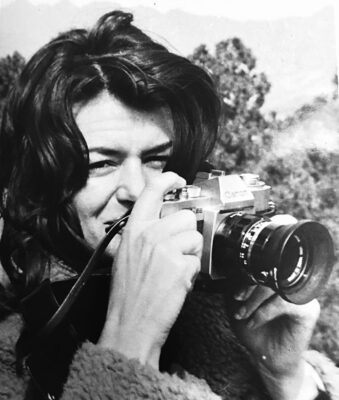
Marysia Lewandowska said: ‘how to pass through a door — my latest sound installation, has been conceived as a tribute to Maggie Keswick Jencks and her contribution to designing, managing and collaborating with her husband Charles Jencks on the transformation of their family home, known as The Cosmic House (1978–1983). By placing the voice at the centre of the project, the house will act like a well-tempered instrument accelerating its most recent transition from a former home to its current museum status.
The voice can never be mistaken for another, it forever belongs to a person and beckons its owner into being. For the duration of the project the Cosmic House will become the site of a new narrative led by Maggie Keswick […] The installation consists of several audio recordings strategically positioned around the Cosmic House, connecting the imaginary with the actual in a quest of finding a proper place where representations are embedded rather than imposed.’
The installation can be viewed at The Cosmic House between 10 October 2022 – 10 September 2023. The tickets will go live on Friday 16 September.
To book please visit https://artsvp.co/thecosmichouse.
Marysia Lewandowska
Marysia Lewandowska, the Polish-born, London based artist has been exploring the public functions of archives, museums and exhibitions for the last 20 years. Her projects include the Women’s Audio Archive (2009); Undoing Property? (Sternberg Press, 2013); The V&A Pavilion of Applied Arts It’s About Time at the 58th Art Biennale in Venice (2019).
Enthusiasts Archive (2019) has been acquired for the collection of Museum of Modern Art, Warsaw. Her work has been presented by Tate Modern, Moderna Museet, Muzeum Sztuki, The New Museum, Whitechapel Gallery. The latest film Dismantling the Faculty of Law features as part of the 11th edition of GIBCA Biennial in Gothenburg, Sweden.
Since 2020 she has been collaborating with Kunsthalle Baden Baden on a long-term project entitled Institutional Healing. She served as Professor of Art in the Public Realm at Konstfack, Stockholm (2003–2013) and Chinese University in Hong Kong (2014–2016). Lewandowska was the first artist in residence to conduct a year-long research project culminating in an art installation at The Cosmic House (2021-2022), hosted by the Jencks Foundation.
Maggie Keswick Jencks
Maggie Keswick Jencks (1941–1995) was a writer, gardener and designer. With her father, she founded the Holywood Trust (Southwest Scotland) and the Keswick Foundation (Hong Kong).
Her book The Chinese Garden was the first major western publication on the intricate designs of the Scholar gardens of Eastern China and she worked as a garden designer. Before her death in 1995 she wrote the blueprint for Maggies Cancer Caring Centres, which now support people with cancer in 27 centres throughout the UK, designed by internationally renowned architects.
The Cosmic House
The Cosmic House, one of the world’s most important examples of Post-Modern architecture, opened to the public as a museum in September 2021. Situated in London’s Holland Park, it became the UK’s first Grade I listed Post-Modern house.
Begun in 1978, the conversion of the house was a collaboration between Charles and Maggie Jencks and the architect Terry Farrell with contributions from Piers Gough, Eduardo Paolozzi, Michael Graves, Allen Jones and others. As the spiritual home of Post-Modern design, it hosted conversations with the leading architects and thinkers of the day. Its symbolic architecture, complex iconography and cosmic references are all imbued with Charles’ characteristic learning and wit.
Jencks Foundation
The Jencks Foundation was set up in September 2021 and launched a programme that builds upon Charles Jencks’ multivalent legacy and the ideas imbued in The Cosmic House. It acts as a cultural laboratory to promote critical experimentation in historical and artistic research.
The Jencks Foundation’s programme is organised around an annual theme and developed through an exhibition, new commissions, residencies, salons and seminars, which, in turn, feed the foundation’s public programme. The foundation also works towards cataloguing and preserving Charles Jencks’ archive and extensive library, and will make these resources available to researchers and the public.
21 September 2021
The Cosmic House Holland Park Opening
Design: Charles Jencks, Architect
Location: London, England, UK
Photographs by Sue Barr
Launch Of The Jencks Foundation At The Cosmic House
Tuesday 21 September 2021 -The Cosmic House, one of the world’s most important examples of Post-Modern architecture, will open to the public on the 24 September 2021. At the same time the new Jencks Foundation will be inaugurated and will launch a programme that builds upon Charles Jencks’ multivalent legacy and the ideas imbued in The Cosmic House.
The Jencks Foundation will act as a cultural laboratory to promote critical experimentation in historical and artistic research. Our laboratory programme will be organized around an annual theme and developed through an exhibition, new commissions, residencies, salons and seminars, which will, in turn, feed the foundation’s future public programme, to be revealed in the coming year.
The Jencks Foundation will also catalogue and preserve Charles Jencks’ archive and extensive library, as the key site of the laboratory programme. The house contains Charles’ archive from his work as a historian, critic, land artist and co-founder of Maggies Cancer Caring Centres. The foundation will open these resources to the public to encourage study of the architecture and culture of the late twentieth and early twenty-first centuries.
The Solar Stair is a cantilever concrete spiral with Eduardo Paolozzi’s Black Hole mosaic at the base:
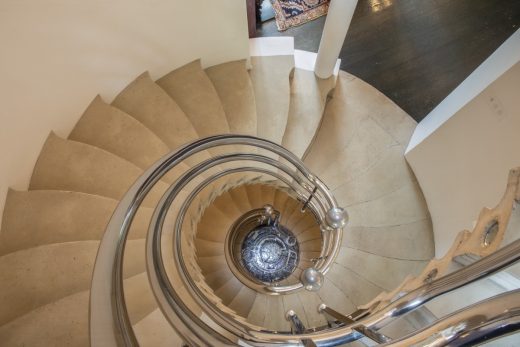
THE COSMIC HOUSE: BACKGROUND
Situated in London’s Holland Park, The Cosmic House became the UK’s first Grade I listed Post-Modern house. Begun in 1978, the conversion of the house was a collaboration between Charles and Maggie Jencks and the architect Terry Farrell with contributions from Piers Gough, Eduardo Paolozzi, Michael Graves, Allen Jones and others. As the spiritual home of Post-Modern design, it hosted conversations with the leading architects and thinkers of the day. Its symbolic architecture, complex iconography and cosmic references are all imbued with Charles’ characteristic learning and wit.
PEOPLE
The Cosmic House steering group is chaired by architecture critic Edwin Heathcote, who Charles titled ‘The Keeper of Meaning’. Also on the steering group is Catherine Ince, Richard Calvocoressi, Madelon Vriesendorp, and the foundation’s Director Lily Jencks, daughter of Maggie and Charles Jencks. Eszter Steierhoffer is the foundation’s Artistic Director.
Edwin Heathcote, The Keeper of Meaning at The Cosmic House said: ‘With the Jencks Foundation we continue the intellectual breadth, the sense of inquiry, humour and curiosity which Charles Jencks embodied. In our programme we hope to maintain his particular and often eccentric cocktail of interests and passions to inspire future generations to think about architecture, science, the cosmos and our place in it.’
NEW INTERPRETATION OF THE COSMIC HOUSE
A new identity and website are designed for The Cosmic House and the Jencks Foundation by John Morgan studio. The website, conceived as the Jencks Foundation’s virtual building, will be launched in two phases. The first, at www.thecosmichouse.org contains information about the history and the design of the house and allows visitors to book their tickets. In a second phase, in January 2022, the foundation will launch its full website which will contain editorial content, a broader selection of writings and drawings from the Jencks Archive, and will act as a publishing platform to disseminate the laboratory and public programmes of the foundation.
Inside the house a newly commissioned interpretative programme will aid visitors to navigate the rich and complex designs of The Cosmic House. A short film by Zuketa introduces the key ideas and protagonists behind the architecture and life of the house, including interviews with Sir Terry Farrell, Piers Gough, Madelon Vriesendorp, and archival footage of Charles Jencks presenting the house after its completion in the mid-1980s.
A comprehensive guide, written by Edwin Heathcote and interspersed with Charles’ voice as both critic and architect, provides a detailed account of the symbolic program, collaborations with artists and designers, and some memories of how the family inhabited the house. The free guide works in unison with a subtle wayfinding system, both designed by Christopher Lawson.
The newly designed Gallery at The Cosmic House will open with a display titled ‘Cosmic, Comic, Cosmetic: Themes and Designs for a House’. It brings together materials from the Jencks Archive that outline the history of the building and some of the key influences and collaborations that shaped the ideas behind its design. The display includes early and rejected designs, sketches, models, working drawings and some key references for the design of The Cosmic House by the Jenckses, Terry Farrell and many of the other collaborating artists and architects, including Michael Graves, Piers Gough, Rem Koolhaas, Eduardo Paolozzi and Celia Scott.
On the first floor of the house, an archival reading space will complement the gallery to allow the public to directly access and handle selected materials from the Jencks Archive. The archival furniture is a new commission by the designer Bahbak Hashemi-Nezhad.
Eszter Steierhoffer, Artistic Director of the Jencks Foundation and curator of the first display said: ‘The drawings and documents on display are selected to help further contextualise and explain the complex iconography behind the design, and to give a sense of the cultural debates that were activated by The Cosmic House, Jencks’ built manifesto of Post-Modernism. This inaugural display is our first dive into Jencks’ rich and diverse archive held at the house, which is being catalogued now, and is the main inspiration and driving force for research and the public programme at the Jencks Foundation.’
The Sundial Room faces south over the garden the room with radial seating around a sundial:
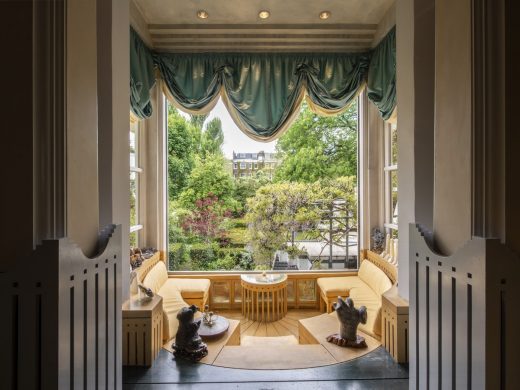
JENCKS FOUNDATION’S PROGRAMME:
ARCHIVE AND RESIDENCIES
As cataloguing of Charles’ extensive Post-Modern archive begins, the Jencks Foundation will launch its laboratory programme centered around research into the archive, with salons, seminars and residencies, which build upon Charles’ legacy. This laboratory program will feed into a public program that will launch at the house and online, later this year.
The Jencks Foundation will launch two residency programs. One long-term residency will delve into and produce work in our archives.
We are thrilled to announce our first resident, renowned artist Marysia Lewandowska, who will be working with us throughout the next year in our research residency to aid and complement the initial cataloguing of the Jencks Archive through her artistic research. Lewandowska said ‘May we consider the archive as a source of nourishment and not a sediment, an open-ended construction of contributions, interpretations, a collaborative effort based on generosity? In the archive interpretations are invited and not already determined, which opens up a creative space for an artist to respond to. The idea of cosmic time embedded in the practice and vision of Charles and Maggie Jencks articulated by The Cosmic House and its archive, presents a unique discursive terrain, where representations as well as temporalities may be given a chance to be constructed anew.’
Our second residency will be an open call to artists and designers to engage diverse communities – locally and internationally – and to invent new formats of ‘hosting’ that encourage a meeting of minds around Post-Modern cultures or Cosmic themes from the Jencks Archive. We encourage educators to use The Cosmic House and the Jencks Archive as a generative resource. More information will be announced on our website.
Lily Jencks, Director of the Jencks Foundation said ‘I’m delighted with Eszter’s dual approach for the new programme that will spend this first year focusing on the laboratory of salons, seminars, and archiving, to encourage deeper debate and reflection, that will feed into the public programme. Just as my father loved to provoke, the design of The Cosmic House is an obvious provocation; we are committed to seek alternative points of view, and embrace multidisciplinary collaborators and audiences by connecting architectural narratives with their broader cultural meaning’.
The Four Square Room is Charles and Maggies bedroom with many iterations of the subdivided square motif with mirrors and split levels creating spatial jokes and ambiguities:
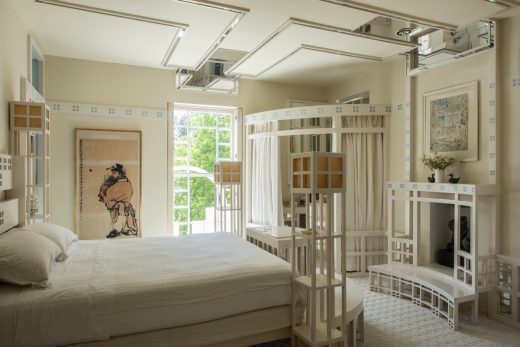
ABOUT THE RIBA CHARLES JENCKS AWARD
The Jencks Foundation and the RIBA will continue the Jencks Award that was established in 1993, as a way of recognising Charles’ vast contribution to architectural culture and in order to honour the plurality of perspectives that he celebrated in his works as a writer and critic. It will also acknowledge the broader cultures of architecture globally and the changing issues which the profession addresses, constantly expanding the idea of theory and recognising new challenges and forms of practice.
The recipient of the RIBA Charles Jencks Award 2021 is Indian architect Anupama Kundoo. Anupama will be presented with the award on Tuesday 2 November at 6.30pm after which she will deliver a lecture and be interviewed by a critic in collaboration with the New Architecture Writers program, with questions from an online audience.
Tickets to attend the Anupama Kundoo lecture are available here:
https://www.eventbrite.co.uk/e/riba-charles-jencks-award-2021-anupama-kundoo-tickets-166907513867
BIOGRAPHIES
Edwin Heathcote is the architecture and design critic of The Financial Times. He is an architect and the author of a number of books including The Meaning of Home and The Architecture of Hope (with Charles Jencks). He is the founder and editor of online design writing archive readingdesign.org and was a friend and collaborator of Charles over many years. He was anointed ‘Keeper of Meaning’ for the Cosmic House by Charles in 2019.
Lily Jencks is an architectural and landscape designer. She founded Jencks Squared, a landart company with Charles, her father, in 2010, and worked on projects in collaboration with him in South Korea, Scotland, as well as designing the new exhibition space at The Cosmic House. Lily also runs her own eponymous design studio. She taught design units Dip13 and Exp13 at the Architectural Association 2015-2021. She sits on the board of the Maggies Centers in Hong Kong. Lily aims to dance lightly with the legacy of her parents.
Eszter Steierhoffer is an art historian and curator based in London. Previous to her role as Artistic Director at the Jencks Foundation, she was Senior Curator at the Design Museum in London and Curator of Contemporary Architecture at the Canadian Centre for Architecture in Montreal, where she curated a number of thematic exhibitions to situate architecture in its broader cultural, historical, and socio-political contexts. She received her PhD degree from the Royal College of Art, her academic research revolves around the histories and exhibitions of Post-Modern architecture.
Charles Jencks (1939–2019) was the leading proponent of Post-Modernism, a writer, critic and also later a landscape designer. He was instrumental in formulating the ideas and theory around Post-Modernism in architecture and broader culture, and, through his books, in making those ideas accessible and universal.
Born in Baltimore, he studied at Harvard and was inspired by the building of Le Corbusier’s Carpenter Centre to go on to study architecture, first in the US and then in London where he moved and stayed. His books, including Modern Movements in Architecture and The Language of Post-Modern Architecture were published in multiple editions and were translated into dozens of languages making him, arguably, the best-known and most influential architecture critic and writer of his era.
He designed The Cosmic House, based in a Victorian villa in London’s Holland Park, with his wife Maggie, the architect Terry Farrell and collaborators between 1978–1983.
Together with Maggie, he founded/commissioned the Maggie’s Centres, a network of support centres for cancer care based in buildings designed by internationally-renowned architects including their friends Frank Gehry, Zaha Hadid, Rem Koolhaas, Norman Foster and others. Maggie died from cancer in 1995.
Charles continued to live at The Cosmic House with his children, John and Lily and with his wife Louisa Lane-Fox.
The Cosmic Oval at the entrance sets up the major and minor themes that visitors will find throughout the house:
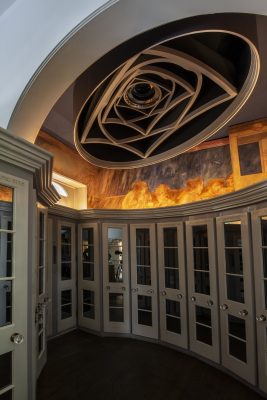
Maggie Keswick Jencks (1941–1995) was a writer, gardener and designer. With her father, she founded the Holywood Trust (south-west Scotland) and the Keswick Foundation (Hong Kong).
Her book The Chinese Garden was the first major western publication on the intricate designs of the Scholars gardens of Eastern China and she worked as a garden designer.
Before her death in 1995 she wrote the blueprint for Maggies Cancer Caring Centres, which now support people with cancer in 27 centres throughout the UK, designed by internationally renowned architects.
Marysia Lewandowska, the Polish-born, London based artist has been exploring the public functions of archives, museums and exhibitions for the last 20 years. Her projects include the Women’s Audio Archive (2009); Undoing Property? (Sternberg Press, 2013); The V&A Pavilion of Applied Arts It’s About Time at the 58th Art Biennale in Venice (2019). Enthusiasts Archive (2019) has been acquired for the collection of Museum of Modern Art, Warsaw. Her work has been presented by Tate Modern, Moderna Museet, Muzeum Sztuki, The New Museum, Whitechapel Gallery. The latest film Dismantling the Faculty of Law features as part of the 11th edition of GIBCA Biennial in Gothenburg, Sweden. Since 2020 she has been collaborating with Kunsthalle Baden Baden on a long-term project entitled Institutional Healing. Gandy gallery in Bratislava is currently presenting The Faculty of Longing a new installation of photography and sound. She served as Professor of Art in the Public Realm at Konstfack, Stockholm (2003–2013) and Chinese University in Hong Kong (2014–2016).
Anupama Kundoo trained as an architect in Mumbai before building a substantial body of work in the experimental town of Auroville, in Puducheery from 1990–2005. Working in this environment she developed a long-term research project into sustainable and building technologies with an experimental approach to material reuse and sustainable construction methods. Anupama’s practice is holistic, combining research, building and teaching to create architecture outside of the mainstream of the commercial, developer-driven world. Her practice has a strong theoretical and ideological conviction that drives material research, collaborates with local builders, and experiments with sustainable working methods.
Previously on e-architect:
17 June 2021
The Cosmic House Holland Park To Open
Design: Charles Jencks Architect
Location: London, England, UK
The Garden facade with a representation of the family of four through the repeated ‘Jencksiana’ motif:
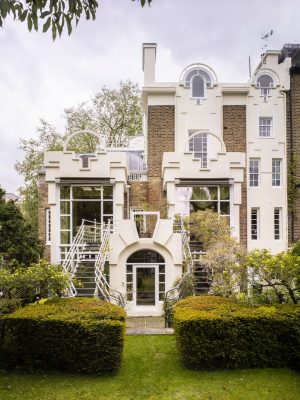
Photos by Sue Barr
Charles Jencks’ Post-modernist Masterpiece To Open To The Public
Thursday 17th of June 2021 – The Cosmic House in Holland Park, the former home of the globally renowned architectural historian and cultural theorist, Charles Jencks (1939 -2019) will open to the public on 24 September 2021 as a museum and archive which will host a programme of exhibitions, talks, and residencies.
The Cosmic House is one of the world’s most important examples of postmodern architecture and design and the UK’s only Grade I listed Post War home. Begun in 1978, the conversion of the house was a collaboration between Charles and Maggie Jencks and the architect Terry Farrell with contributions from Piers Gough, Eduardo Paolozzi, Michael Graves, Allen Jones and others. As the spiritual home of Postmodernist design, it hosted conversations with the leading architects and thinkers of the day. Its symbolic architecture, complex iconography and cosmic references are all imbued with Jencks’ characteristic learning and wit.
The house will be open to the public for small groups, providing an opportunity to explore the remarkable interior close up.
The Winter Room has a fireplace designed by Michael Graves with Celia Scott’s bust of Hephaestus looking over the room with Chinese Scholar’s Rocks solid dynamics replacing the fire’s flames. The view shows the layering of space with views into the Spring, Summer and Autumn rooms (views through the seasons):
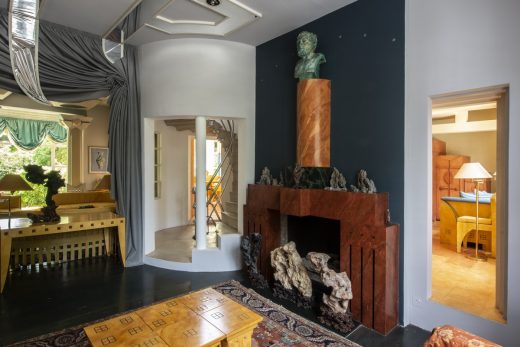
Jencks Foundation
The newly established Jencks Foundation will cultivate and build on the legacy of Charles Jencks’ provocative and wide ranging work. It will act as a cultural laboratory and promote critical experimentation in historic, artistic and scientific research through grants and residencies, and a related programme of exhibitions, lectures, and publications.
It will also oversee and preserve Jencks’ archive and extensive library and open these key resources to encourage the study of the architecture and culture of the late twentieth and early twenty first centuries.
The Jencks Foundation’s inaugural programme will develop from interpretation of and research into the archives of The Cosmic House, and its first exhibition will be an exploration of materials relating to the design of the house itself. The Jencks Foundation’s public programme will be promoted through a network of partnerships in London and internationally.
Lily Jencks, co-designer of the new gallery at The Cosmic House and Director of the Jencks Foundation, said: “My parents designed the Cosmic House as a playful polemic. With the Jencks Foundation we hope it will continue to provoke the cultural conversation, and provide a platform for those engaging with the broadest and deepest meaning in architecture, helping with the patient search for its cosmic context.”
Eszter Steierhoffer, Artistic Director of the Jencks Foundation, said: “The Jencks Foundation will become a new cultural hub in London. Its public programme will revolve around thematic seasons inspired by the Jencks Archive. It will foreground the hybrid connections between architecture and other disciplines, and invite artists, designers and researchers to experiment with the postmodern.”
Edwin Heathcote, Chair of the Steering Group said: “I was anointed ‘Keeper of Meaning’ by Charles Jencks. It is the most typically and wonderfully Jencksian job description. The Cosmic House is a manifesto of Post Modernism, rich, kitsch and endlessly inventive. The Jencks Foundation aims to be for contemporary architectural and cultural discourse what the house was for its era, a place of conversation, thinking and meaning.”
The Architectural Library is Charles’ study with a tent-like roof painted to be like the sky, with its ‘City of Books’ designed by Charles so that each bookshelf relates to the thematic style or individual architect whose books are collected therein:
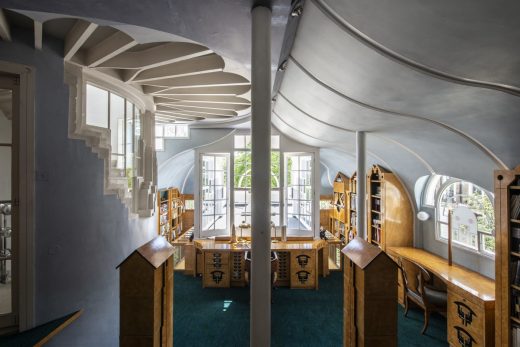
Charles Jencks and The Cosmic House
The Dome of Water is a jacuzzi designed by Piers Gough, adapted and inverted from dome by Francesco Borromini:
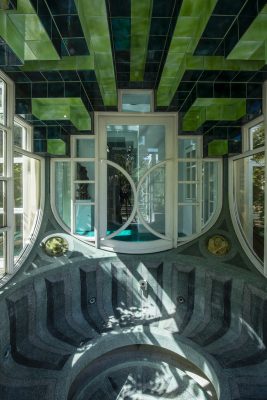
Charles Jencks (1939-2019) designed The Cosmic House, based in a Victorian villa in London’s Holland Park, with his wife Maggie and the architect Terry Farrell in 1978. The interior features contributions from and collaborations with other architects and artists including Michael Graves, Piers Gough, Eduardo Paolozzi, Allen Jones and others.
Together with Maggie, Jencks founded/commissioned the Maggie’s Centres, a network of support centres for cancer care based in buildings designed by internationally renowned architects including their friends Frank Gehry, Zaha Hadid, Rem Koolhaas, Norman Foster and others. Maggie died from cancer in 1995.
Charles Jencks continued to live at the Cosmic House with his children, John and Lily and with his wife Louisa Lane Fox.
The new Exhibition Room with the evolution of scientific representations of the sun in the ceiling lights, looking out to the Time Garden, with a malachite floor and sculpture by Charles and Lily Jencks of the sun and earth above:
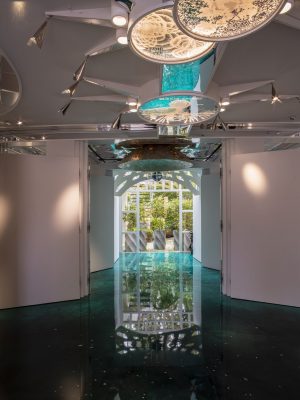
The Cosmic House London Home
Information for visits:
The Cosmic House will be open on 24 September 2021.
Visits can be booked through the website www.thecosmichouse.com from September.
Photos: Sue Barr
The Cosmic House Holland Park images / information received 170621
Location: Holland Park, West London, England, UK
North London Homes
North London Houses
Design: LLI Design
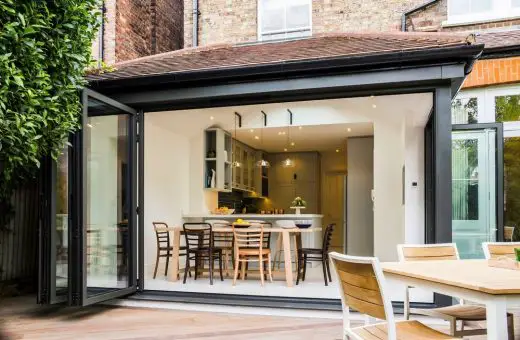
photograph © Rick Mccullagh / LLI Design
Victorian Townhouse in Highgate
Roof Conversion, Crouch End, North London
Design: JaK Studio, Architects
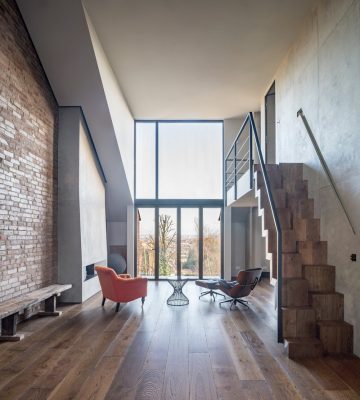
photo : Francesco Russo
Crouch End Flat Extension
Dukes House, Alexandra Palace, Muswell Hill
Structural Engineer: TZG Partnership
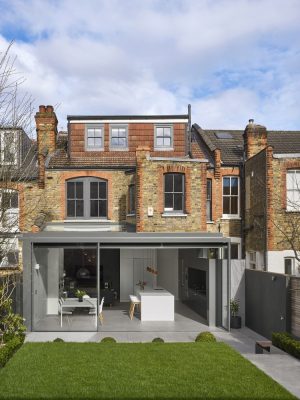
photograph : Will Pryce
Dukes House in Muswell Hill
Design: Claridge Architects
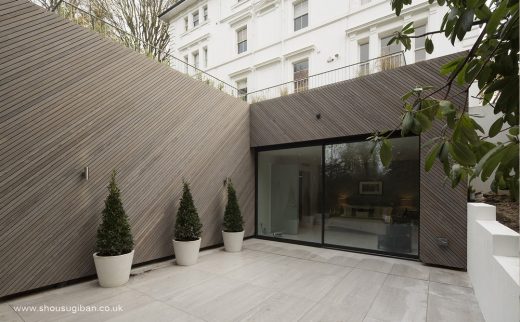
photograph : Simon Kennedy
New Hampstead House
London Architecture
Contemporary London Architectural Projects, chronological:
London Architecture Designs – chronological list
London Architecture Walking Tours
Buildings / photos for the The Cosmic House Holland Park, London, England design by Charles Jencks Architect page welcome

